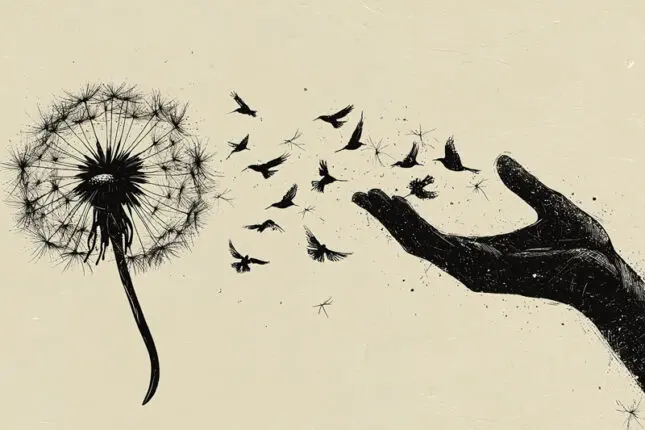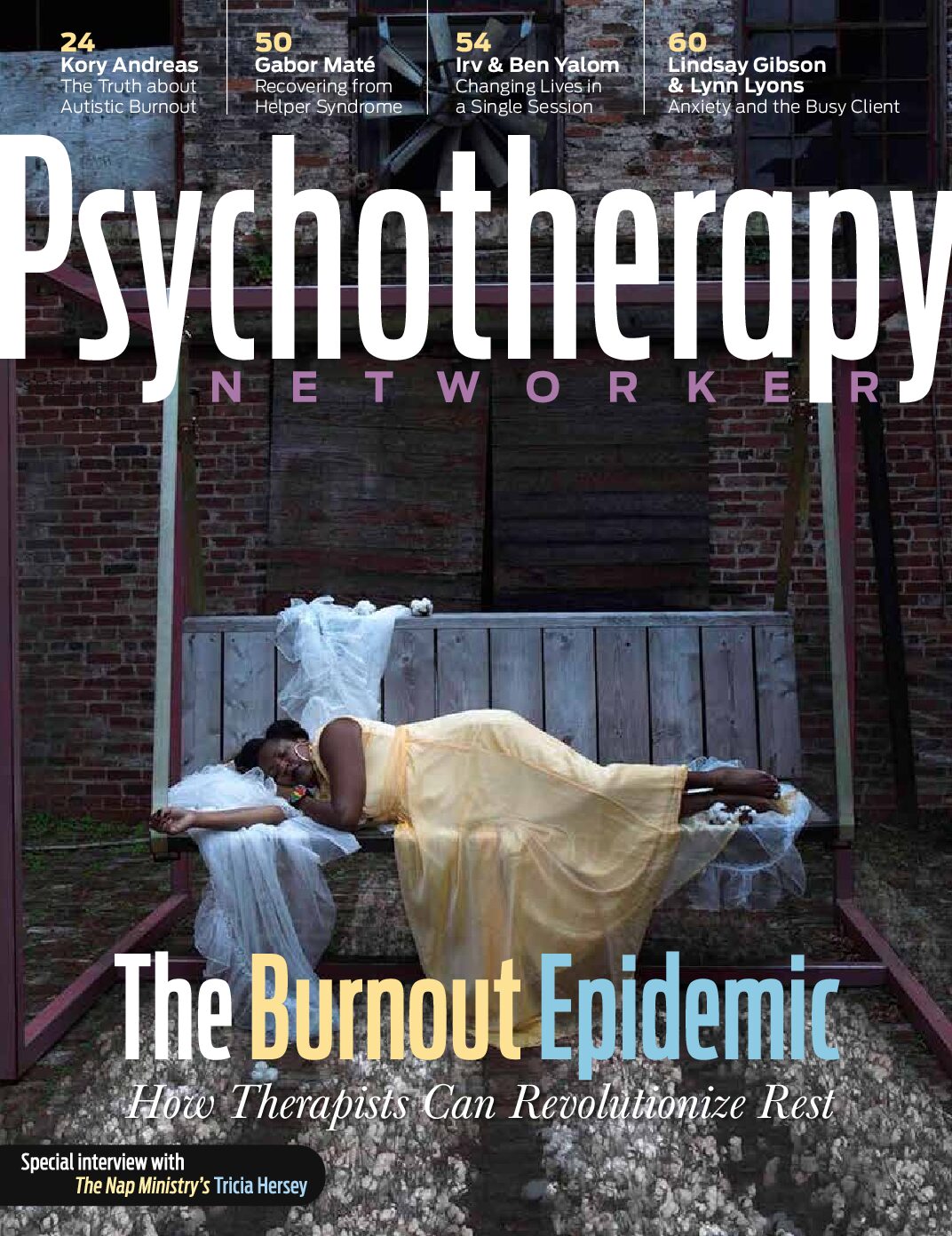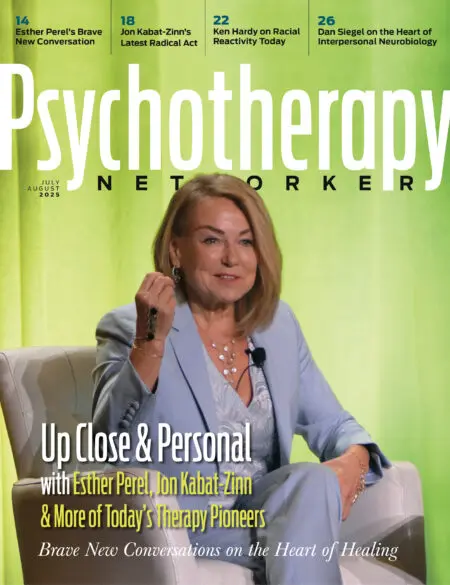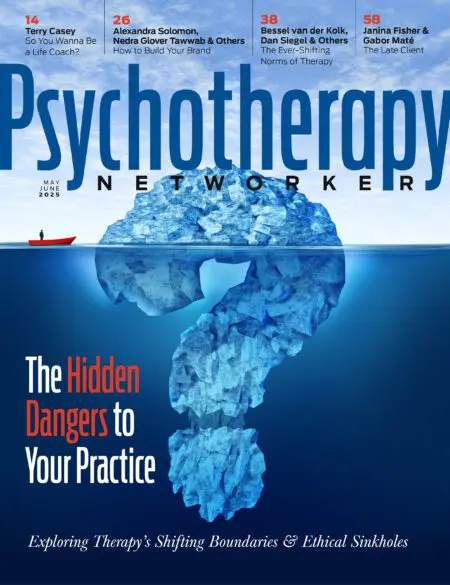Enjoy the audio version of this article—perfect for listening on the go.
Q: My client comes into every session bitter and upset about a former friend who betrayed her. How can I confront this pattern without invalidating my client’s anger and hurt?
A: Over 30 years, while working with clients in private practice and community mental health settings, I’ve frequently seen this pattern of clients holding grudges that impede their therapeutic progress. I’ve also seen how these grudges prevent people from letting go of past harmful relationships or moving on to form new relationships that might help them grow and thrive. I’ve come to call it the “not-forgiving holding pattern” or as psychologist Fred Luskin called it, a “grievance story,” because even though the wrongs suffered by the client are in the past, it’s hard for them to move out of the familiar state of feeling emotionally wronged.
Take my client Dan. When he first entered my office, his leg bounced so hard from nervousness that it rattled the glass table next to the sofa. His phone was on his lap. He clicked the home button each time his leg shook. The blue “F” of the Facebook app flashed as he absently locked and unlocked his phone without once glancing down to look at the screen.
“I only check once a day now,” he said with a wan smile. “We have mutual friends who comment on the pictures, so it’s hard to ignore her feed.” At my suggestion, he put his phone on the table but continued glancing at it every few minutes.
Dan sought therapy after his ex-wife Carol gave birth to her first child with her new partner, further cementing the realization that she’d moved on and was finding happiness in a new relationship. Dan was taken aback by the visceral reaction the news caused him. He didn’t feel jealousy or romantic nostalgia toward Carol, but any happiness Carol experienced in her life felt like a personal affront. It reawakened and amplified the pain she’d caused him years ago, which had led to the end of their marriage two years earlier.
His resentment manifested in his obsessively monitoring Carol’s life. He checked her social media pages multiple times a day, integrating the monitoring into his everyday rituals: scrolling through her Facebook page while drinking his morning coffee, checking again on his lunch break at work, checking while preparing dinner, and again before bed. Dan claimed his hatred for Carol and his desire to see her experience pain in her life without him fueled these behaviors. Alternatively, evidence of an absence of pain—or of the presence of happiness—in Carol’s life sent Dan into a cycle of resentment followed by shame. Why do I care so much about her life? he berated himself. It was clear she no longer seemed to care about him.
I’ve seen this pattern of resentment and monitoring in couples and families, and in work I’ve done as a mediator. As a counselor educator teaching the process of forgiveness to clinical mental health counselor students, I’ve heard two questions come up regularly: If this pattern is so destructive, why do people engage in it? And why do so many of our clients stay stuck in it for so long? Here are a few common reasons.
It provides a false sense of empowerment. Keeping a relationship in the “not forgiven” holding pattern can feel empowering in the short run. When you choose not to forgive someone, the control of release is entirely in your hands.
It feels vindicating. Any evidence of hardship in Carol’s life (e.g. loss of a job, dissolution of a romantic relationship) kindled the schadenfreude that strengthened Dan’s sense of self-righteousness. He could tell himself, “See! That’s what she gets for being so awful to me. And clearly, I was right about the criticisms, judgements, and accusations I’ve made about her all these years. She’s getting what she deserves.” Evidence of hardship can give us the false sense that the offender is being punished.
It provides a false sense of safety. Dan holds on to the belief that not forgiving Carol protects him from being hurt by her again. He keeps his defenses up to stay safe, ignoring the fact that he’s living as if he’s in a constant state of being under attack.
It shields us from uncomfortable feelings. Engaging in the cycle of checking Carol’s Facebook page kept Dan too busy to experience the full grief process. His anger and resentment blinded him to the time he was losing by engaging in these repetitive behaviors.
It provides energy. Often, remaining stuck in this cycle can give us what feels like energy or courage to assert ourselves and our point of view. It can also provide energy to do something when we struggle to find the energy to do anything.
It’s easier than the alternative. Many people stay stuck in this pattern because they don’t know how to forgive. Some view forgiveness as a religious concept rather than a tool for healthy relationships. For some, the word “forgiveness” itself becomes a roadblock because they think forgiveness means you’re agreeing with or endorsing another’s behaviors or forgetting the pain you suffered.
Logically, Dan understood that his resentment wasn’t hurting Carol. She was living her life, seemingly happy and free without him. Dan was locked in a resentment holding pattern toward Carol, yet it wasn’t changing her actions or behaviors towards him. She hadn’t reached out to him in years. She hadn’t atoned for the hurtful things she’d said and done to him in the ways Dan felt she should. Dan believed this was why he was still suffering.
Dan admitted that he hid his behavior from his friends and family, particularly his mother, with whom he had a close relationship. The situation had also cost him a romantic relationship. When monitoring Carol’s social media didn’t yield the satisfaction he craved, Dan grew irritable for several hours, sometimes lashing out in anger toward his new partner for small affronts or missteps. Although he felt resentment towards the mutual friends who hadn’t cut ties with Carol after the two of them split, he still remained connected to them on social media so he could more closely monitor Carol. He tracked and logged their friendly interactions with Carol and grew increasingly conflicted and bitter towards them.
At the start of one of our sessions, when Dan was beginning once again to list the injustices he’d suffered at Carol’s hands, I interrupted him.
“Dan,” I said. “Would you mind if we did something a little different today? Something that might help you free yourself from the grip of this resentment?”
“I guess,” Dan said, shrugging.
“I know Carol has hurt you badly, and I know you feel like she needs to ask your forgiveness in order for you to move on. But what if there were another way?”
“I wish there were,” he said. “But I’ve tried everything.”
“Well, are you open to the idea of forgiving Carol for what she’s done?”
Dan’s eyes widened. He looked visibly angry with me.
“Are you kidding?” he sputtered. “After everything she’s done?”
“Well, in this situation, forgiveness is not a way to release Carol from responsibility or restore your relationship. Rather, it’s a way for you to let go of the pain and find some peace and freedom.”
Initially, Dan didn’t want to “let her off the hook.” Instead of anticipating relief, Dan feared the emptiness that would be left if he let go of the resentment that had become the most tangible and all-consuming focus of his life.
Forgiveness as Self Care
At this point, we began to explore forgiveness as a form of self-care. I call self-caring forgiveness selfish forgiveness, a common term for forgiving someone for your own mental health and well-being. Putting the word “selfish” together with “forgiveness” may seem paradoxical, but a healthy tension results from combining these two ideas. Framing it this way frees a client from any moral obligation to “do good” for abstract reasons. This terminology distinguishes this type of forgiveness from the toxic positivity of a culture that insists we have to forgive to be “good” or “spiritual.” It positions a client’s inner peace ahead of social norms that prioritize interpersonal amicability at the expense of the self.
Selfish forgiveness can be defined as letting go of resentment—not to restore an ailing relationship, but for one’s own well-being and happiness. It’s especially useful in situations like Dan’s where one party is absent and/or lacks remorse, thereby rendering interpersonal forgiveness difficult or impossible. If we could remove Carol from Dan’s forgiveness process, we might be able to genuinely empower him to move on. He could begin the journey toward finding closure in his post-Carol life, and over time, his well-being would become less contingent on Carol’s actions or inactions. The day might even come when he would no longer feel compelled to keep tabs on her.
Selfish Forgiveness and the Stages of Change
When transforming the cycle of resentment into selfish forgiveness, it can be helpful to view forgiveness through the lens of Prochaska and DiClemente’s Stages of Change framework. This framework provides a roadmap for the forgiveness process.
In the first stage, precontemplation, Dan was either unaware of a problem or did not see the need to change his behavior because he saw Carol as the problem. In the second stage, contemplation, Dan acknowledged that there was a problem and that he was contributing to it. He also grew more open to the possibility of changing his actions at some future time. Dan was in the contemplation stage when he sought counseling. He identified his obsessive monitoring of Carol’s social media as problematic but could not tangibly envision a future where he wasn’t compelled to engage in these actions, which caused him unhappiness and fueled his irritability and sense of helplessness. Dan was more focused on Carol’s role in contributing to his actions than on his own sense of agency. At this stage, it felt as if his behaviors were a natural result of her past actions towards him, which left him feeling powerless to change.
Understanding the concept of selfish forgiveness, and the ways engaging in it could free him from suffering, helped Dan move from contemplation to stage 3: preparation. By reiterating that forgiveness would be intrapersonal—meaning an experience that took place within his own psyche—and not something that happened between him and Carol, Dan started planning to change some of the behaviors and actions he’d been engaging in that were harmful to him. Preparation is marked by a shift in focus towards one’s own behavior along with the formulation of a concrete plan to change. After cutting down the number of times he checked Carol’s social media daily from five or six times a day to once daily, Dan resolved to block Carol on Facebook so he could no longer see her page. Taking this step wasn’t easy for him, but once he did, it diminished the pain he felt about her past actions by removing the triggers of her posts and their old friends’ responses to her posts. This didn’t mean Dan didn’t still hold Carol accountable for her past harmful actions toward him—he did. It meant he didn’t experience the same level of resentment.
When moving out of preparation and into the action and maintenance stages, it’s important to move the forgiveness process from an interpersonal focus to changing one’s own actions and habits. The shift must support intrapersonal forgiveness and self-care. An interpersonal forgiveness process—one that depends on another person’s actions and behaviors—can be undone by outside factors such as seeing the person who hurt you in public or experiencing a new partner exhibiting similar behaviors to the ones that caused you pain in the past. When forgiveness is firmly established as an internal process of self-care, however, control stays with the forgiver.
While moving from preparation to action, Dan was still vulnerable to resentment, even as he resolved to let it go. We employed the metaphor of having a kitchen full of smoke after something had burned on a stove. If this happened, it made sense to grab a dishtowel or some other item that would help you fan the unpleasant smoke out of the kitchen. The idea of fanning out the smoke for the sake of the smoke was laughable. Of course, he’d fan the smoke out for himself—not because the smoke “wanted” to be free. He was the one inhaling the smoke. It hurt his lungs, and he wanted to be rid of it. Fanning out all the smoke would take some time and work, and maybe some remaining smoky smell might resurface now and again. But eventually, the air in his kitchen would be clear once again.
Most changes, including forgiveness, aren’t simple or absolute. People in our lives don’t fall into rigid, binary camps: “forgiven” or “not forgiven.” Forgiveness is ongoing. It happens in degrees. The same is true for the act of forgiveness. Selfish forgiveness requires a reenvisioning of forgiveness as an emerging process that shows up in the behaviors we engage in every day. Do the things we do stoke or reduce resentment? Forgiveness isn’t a one-time event that happens and is over forever. It begins, takes place in fits and starts, and in some situations, may never be completely over. And that’s okay.
Dan hasn’t yet fully forgiven Carol. He hasn’t completely purged his resentment towards her from his heart and mind. But he no longer checks her social media, and he’s hopeful that one day he’ll be free of the pain their marriage caused him. Author Lewis Smedes once said that to forgive is to learn to live with an uneven score. Perhaps, in the case of selfish forgiveness, to forgive is to embrace the possibility that the score isn’t worth keeping if it comes at the expense of your own happiness.
Alan Demmitt
Alan Demmitt, PhD, is an associate professor of counseling at the University of Dayton.
Krystel Chenault
Krystel Chenault, MA, is a PhD student and the creative director at an education publisher.














